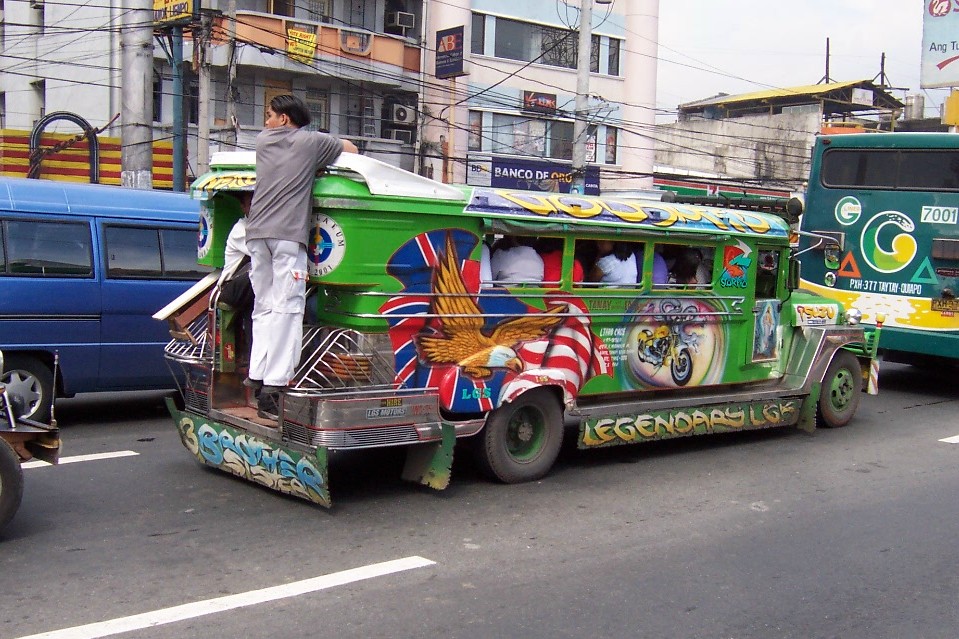...disorganized transport (ii)

Problems with free market transportation strategies:
From a pure economic efficiency standpoint, a laissez-faire regime in transportation delivers the services directly to the needs -so it is very responsive.
But the logic of market also creates problems. Maximizing resources means stuffing as many people as you can into the vehicle ("Konting ipit lang po, pituhan yan!"), and using the vehicles for as long as they can run on the road.
So you get overstuffed vehicles; "aircon" buses that have no airconditioning to speak of; buses, jeeps and taxis on the road that are probably held together by electrical tape. ( This was made worse in the late 80's when, in response to a transport crisis, DOTC (then under Oscar Orbos) liberalized the imporation of second-hand buses.)
The market also quickly retreats when it isn't cost effective to be running services -i.e., everytime there is a massive traffic jam or downpour, the buses and jeeps disappear because being stuck in traffic eats into their earnings -leaving commuters stranded and exacerbating the situation.
There are no safeguards for the welfare of the passengers and the regulatory regime only has control over fares and emissions. So you get the nearly annual transport strike as they agitate for higher fares. (One can only dream that there would somehow be a "pasahero strike" so passengers can get a better deal.)
Programs such as the Organized Bus Route, the AUV Express (which the FX drivers can't seem to get organized enough to protest), the CNG/NGVPPT, and the Greater Manila Mass Transport System are attempts by the government to impose order after the market has organized itself.
(It's noteworthy that the government feels they are doing the FX drivers a favor by legalizing them under the "AUV Express" regime and that the FX operators are protesting the requirement that they only stop at designated points on the route and set-up terminals complete with restrooms and waiting areas -regulations after the fact.)
What the national government/MMDA and the city governments are looking for is the right incentives vs. regulations approach that will control the free market without stiffling the entrepreneurship or the profit motive.
What the national government/MMDA and the city governments haven't grasped is that public transportation systems are city shapers, and transport nodes (even ones that aren't light rail stations) can be used to the city's advantage -i.e. -by encouraging Transit Oriented Development (TOD) at the nodes.
Imagine if they built affordable high density housing around and on top of FX terminals? All the makati white-collar workers would buy/rent the units. If the cities owned/developed the terminals, they could also impose no-engine-idling rules to further reduce emissions.
More about non-rail TODs and the "boundary system" as a city-shaper in succeeding posts.

2 comments:
What if the governement decides on a monopoly for public transportation. Meaning they give wages to drivers and conductors etc. and give just prices to commuters.
Not totally monopolizing but just here in the metro manila and nearby cities so it will have more organized routes, less congestion, certain stops, etc.
first they'll have to get over the political mountain of getting the bus operators to give up their routes.
having a salary-driven driver (sorry for the awkward turn of phrase) does mean the bus will run based on schedule. (you can change drivers on shift right at one of the bus stops so the bus continues to turn around)
the defunct MMTC (love buses) we're certainly very dependable. -but it was a losing entity vs. the entrepreneurial bus operators.
same goes for the old JD lines -that have old but very clean buses and employees who seemed to be proud of their work. (the conductors and drivers always had clean, pressed uniforms).
plus, as with all government endeavors, the bureacracy soon gets fat and unresponsive.
I think Manila Water's success as private concessionaire is a good case study.
I don't have a full handle on the program -but using loans/incentives for CNG buses could be used to force the bus operators to coalesce -and move away from the boundary system.
but i'm going too much into my post about the boundary system.
Post a Comment